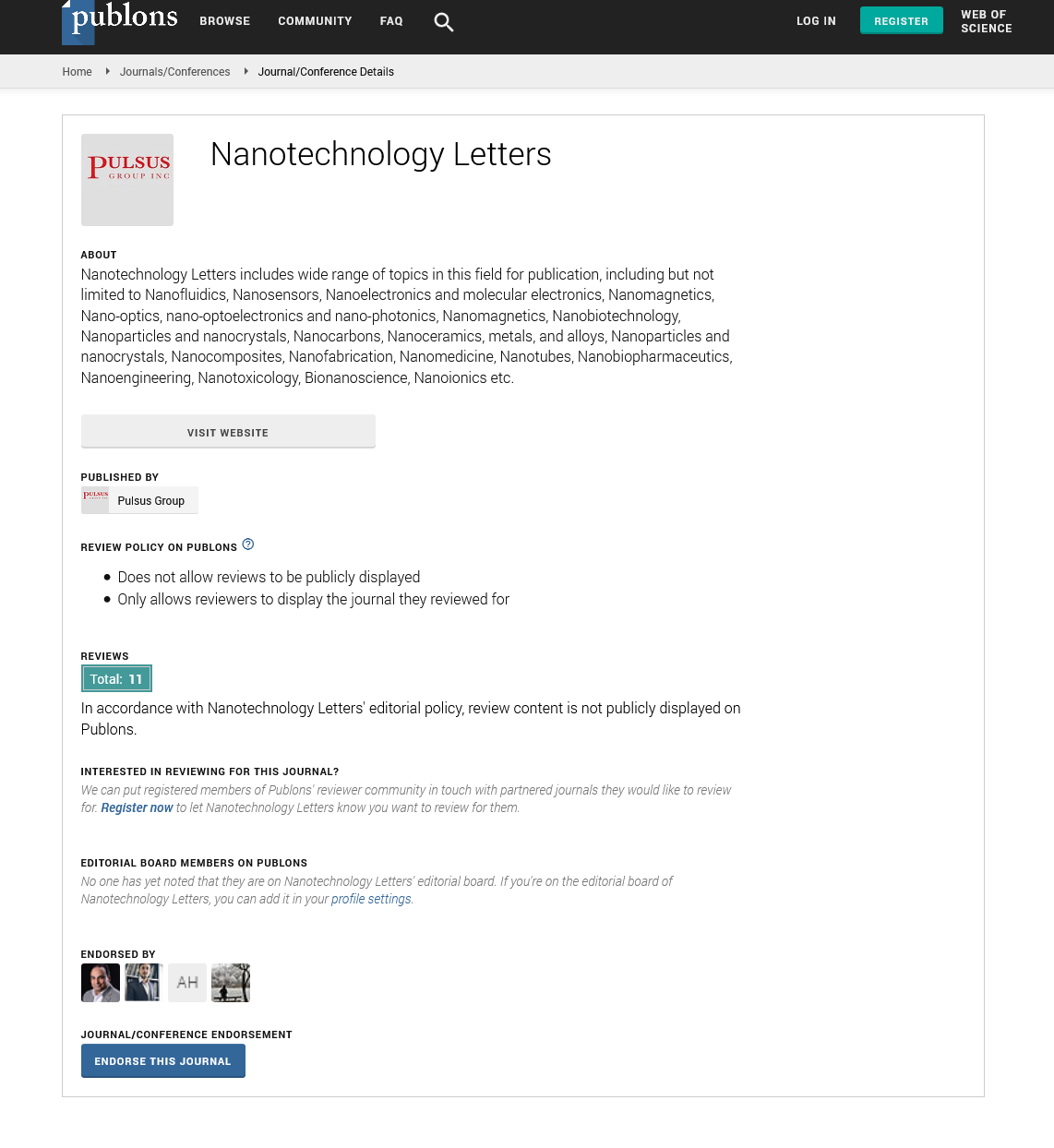Nanotechnology-supported THz medical imaging
Received: 05-Jul-2022, Manuscript No. PULNL-22-5576; Editor assigned: 07-Jul-2022, Pre QC No. PULNL-22-5576 (PQ); Accepted Date: Jul 27, 2022; Reviewed: 13-Jul-2022 QC No. PULNL-22-5576 (Q); Revised: 15-Jul-2022, Manuscript No. PULNL-22-5576 (R); Published: 28-Jul-2022, DOI: 10.37532. pulnl.22.7 (4).01-02
Citation: Lockwood E. Nanotechnology-supported THz medical imaging.Nanotechnol. lett.; 7(4):01-02
This open-access article is distributed under the terms of the Creative Commons Attribution Non-Commercial License (CC BY-NC) (http://creativecommons.org/licenses/by-nc/4.0/), which permits reuse, distribution and reproduction of the article, provided that the original work is properly cited and the reuse is restricted to noncommercial purposes. For commercial reuse, contact reprints@pulsus.com
Introduction
One of the most recent areas of technology and science to catch the interest of scientists is nanotechnology, which is thought to have the ability to completely alter daily life as we have known it thus far. Although it is difficult to pinpoint the beginnings of nanotechnology, no one can dispute that R. Feynman's inspirational lecture "There is plenty of room at the bottom" (December 29, 1959) represents the foundation of the discipline1. Many people think that because this lecture was so outstanding for its time, it served as the beginning of the new scientific discipline of nanotechnology. The significance of nanotechnology lies in the necessity of characterising material dimensions at the nanometer scale in order to determine their properties. Materials display novel physical phenomena or possess new physical properties at such dimensions. The properties of matter are entirely different from what we have been taught at such small dimensions, and new, unusual qualities are seen. The increased surface area per volume and the fact that the material properties follow the laws of quantum mechanics rather than the classical physics at the macroscopic scale give rise to the novel properties at these dimensions. As a result, nanotechnology involves both new, innovative physical features and small dimensions. Many scientists think that nanotechnology's ability to fundamentally alter how things are done and some even question whether it can lead to the next "nano-industrial revolution" due to its powerful developing applications. The use of nanotechnology in medicine, or "nanomedicine," is one field that has shown great promise. Nanotechnology and medicine come together through the emerging subject of nanomedicine to enhance current treatments and medical procedures. The importance of nanomedicine for people has made it one of the most important subfields in nanoscience. Specifically in three important areas: diagnosis, therapy, and regenerative medicine, it is regarded as the greatest challenge in medicine in the twenty-first century. The field of medical imaging and radiology will unavoidably benefit from a scientific and technological area with so many hopes. Since the discovery of X-rays, several non-invasive imaging modalities have been developed, and the field of medical imaging is very vast. There are differences in each modality's ionising or non-ionising nature, sensitivity, resolution, complexity, time required for data acquisition, physical principles, performance parameters, available information, and of course, the associated costs. Each modality also exhibits its own distinct characteristics and inherent limitations. The use of non-invasive and non-ionizing radiation for medical imaging is a topic that interests researchers. Non-invasive imaging techniques have undergone a revolution, according to reports, and those that don't involve ionising radiation minimise patient hazards, allow for repeatable imaging, are frequently painless, and lessen patient suffering. A gap between microscopy and medical imaging, according to Wallace et al., has led to current research efforts to concentrate on creating non-ionizing modalities that can close this gap. Terahertz (THz) imaging is one of the most current and alluring methods that meets these criteria. THz radiation, often called ‘sub-millimetre radiation’ or ‘T-rays’, is commonly described as the frequency range from 100 GHz to 10 THz17 and is actually the gap between the Infrared (IR) and microwaves. Due to the lack of suitable sources (electronic or optical), this area of the electromagnetic spectrum went ignored for a long time, despite the fact that it has several interesting properties and a variety of possible uses. The advancement of THz radiation technology was pushed by the evolution of semiconductor microfabrication processes and the creation of ultra-short optical pulse lasers. Nanotechnology has the potential to improve therapeutic methods and imaging technologies in medicine. Many of the suggested uses still go much beyond what can be accomplished with current nanotechnology methods. The goal of this paper is to evaluate potential non-futuristic uses of THz imaging modalities assisted by nanotechnology. THz imaging employs non-invasive radiation and, while being one of the most alluring new imaging modalities, it has not yet achieved complete acceptance. To do this, it is necessary to first recognise the shortcomings and restrictions of the cutting-edge THz imaging setups.
Method
The current status of THz imaging is briefly discussed in the next section (Background), along with the limitations of these special imaging modalities. The findings of a thorough review on how nanotechnology can support THz imaging are described in the next section. Electronic resources were used in the review's search for pertinent information, including the online databases Scopus, Web of Science, and PubMed. We used Google and Google Scholar to search other resources. Additionally, references that were included in the original articles were also used. The following keywords and indexing terms were used to identify the pertinent studies: terahertz nanoscopy, terahertz imaging, and nanotechnology/nanoscience.
Background
Applications for THz radiation are growing so swiftly that they offer exceptional potential and social impact. These uses can be broadened to include material non-destructive testing and security in addition to medical, scientific, and pharmaceutical applications. Biomedical applications, which could have a significant clinical impact, such as the use of THz radiation as an imaging modality and for spectroscopic research, are of particular interest. Since 1995, when the first biological THz imaging was presented, a novel non-invasive imaging technique has been developed. The contrast process in THz medical imaging results from the fact that, when interacting with THz waves, various biological tissues have varied absorption spectra and refractive indices. As a result, pictures and data from healthy or pathological (abnormal) tissues can be obtained. It was established that the contrast mechanism was the difference water content of two separate tissues (porcine muscle and fat) even from the initial imaging demonstration by Hu and Nuss. The metabolic and morphological characteristics of the tissue have been shown in preliminary experiments to create contrast in images made with THz pulses. The main element in the utilisation of THz radiation for spectroscopy is that the energy of rotational and vibrational molecules, such as proteins and DNA, is equal to that of the THz photons.
THz imaging methods
THz is still evolving in all of its elements, from technological concepts/set-ups to potential applications, despite the fact that the area of medical imaging has made tremendous strides in recent years and considerably contributed to better medical practise for both diagnosis and therapy. More research is still required to better understand the interactions between THzmaterials and tissues as well as the underlying physical and biological mechanisms. The two main categories of THz imaging systems are passive (also known as incoherent) and active (also named Coherent) Continuous or pulsed Since active set-ups are more frequently utilised for medical imaging purposes and passive set-ups are most frequently used for airport security and weapon detection, we are concentrating on active set-ups in this article. Although both continuous and pulsed THz imaging setups are still in development, pulsed systems are more prevalent.
Limitations of THz imaging methods
THz waves' characteristics lead to the first disadvantage of THz imaging. Compared to imaging methods that employ shorter wavelengths, their long wavelength causes restrictions in the imaging resolution. THz imaging can only depict features in the 1 mm-3 mm range due to the long wavelength, which is insufficient for biomedical applications. THz investigations and possible applications have, up to this point, been restricted to surface tissues like the skin, teeth, and the cornea due to the low penetration depth caused by the high body-water component. The highest contrast between healthy and malignant tissues can be achieved by using the 0.5 THz frequency, although this reduces the later THz imaging resolution






